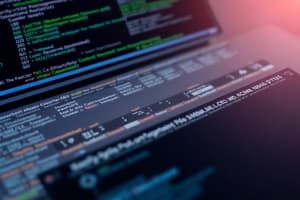Podcast
Questions and Answers
What are the two basic types of software?
What are the two basic types of software?
- Programming software and networking software
- Application software and system software (correct)
- Multitasking software and networking software
- Operating system software and utility software
How does the operating system help manage resources?
How does the operating system help manage resources?
- By creating virtual memory
- By overseeing processor, memory, storage, hardware, and peripheral devices (correct)
- By controlling application software
- By managing network connections
What are the objectives of the boot process?
What are the objectives of the boot process?
- To install new applications
- To help the computer start up (correct)
- To optimize system performance
- To manage user accounts
How is system software categorized?
How is system software categorized?
What does the Task Manager utility program do?
What does the Task Manager utility program do?
How does the operating system help manage resources such as the processor, memory, and storage?
How does the operating system help manage resources such as the processor, memory, and storage?
What are the main features of the Windows interface?
What are the main features of the Windows interface?
What utility programs are included in system software and what do they do?
What utility programs are included in system software and what do they do?
How does the operating system interact with application software?
How does the operating system interact with application software?
What is the role of the operating system in helping the computer start up?
What is the role of the operating system in helping the computer start up?
What software is included in system software?
What software is included in system software?
How does the operating system help keep the computer organized?
How does the operating system help keep the computer organized?
What is an operating system (OS)?
What is an operating system (OS)?
Where are Real-Time Operating Systems (RTOS) commonly used?
Where are Real-Time Operating Systems (RTOS) commonly used?
What do mainframes and network operating systems manage?
What do mainframes and network operating systems manage?
Which are the top three operating systems for personal computers?
Which are the top three operating systems for personal computers?
What is the dominant operating system for mobile devices?
What is the dominant operating system for mobile devices?
What does the user interface enable?
What does the user interface enable?
What does processor management do?
What does processor management do?
What is virtual memory used for?
What is virtual memory used for?
What is the purpose of Real-Time Operating Systems (RTOS)?
What is the purpose of Real-Time Operating Systems (RTOS)?
What is the function of the operating system (OS)?
What is the function of the operating system (OS)?
What is the purpose of preemptive multitasking?
What is the purpose of preemptive multitasking?
What happens when RAM is full and virtual memory is used?
What happens when RAM is full and virtual memory is used?
Flashcards are hidden until you start studying
Study Notes
Understanding System Software Operating Systems
- An operating system (OS) is a group of programs that manages computer functions and consists of the OS and utility programs for system maintenance.
- The OS manages computer hardware, coordinates applications and CPU, and schedules tasks.
- Operating systems are categorized by the devices they are installed in, such as robots, mainframes, network computers, mobile devices, and personal computers.
- Real-Time Operating Systems (RTOS) are designed for machinery performing repetitive tasks and require minimum user interaction, used in devices like TV cameras, cars, and medical equipment.
- Mainframes and network operating systems manage multiple users and multitasking, examples include Windows Server, Linux, and Unix.
- The top three operating systems for personal computers are Windows, Mac OS X, and Linux (open source), with Windows 8 optimized for touch screens and cloud-based OS.
- The dominant operating system for mobile devices is Android, allowing multitasking.
- The OS coordinates and directs the flow of data and information.
- The user interface enables user-computer interaction through command-driven, menu-driven, and graphical interfaces.
- Processor management performs multiple tasks at once, arranges task execution, and handles events like keystrokes and mouse clicks.
- Preemptive multitasking prioritizes high-priority tasks such as printing.
- Virtual memory is used when RAM is full, storing unused instructions on the hard drive, and increasing RAM can reduce the use of virtual memory.
Studying That Suits You
Use AI to generate personalized quizzes and flashcards to suit your learning preferences.




